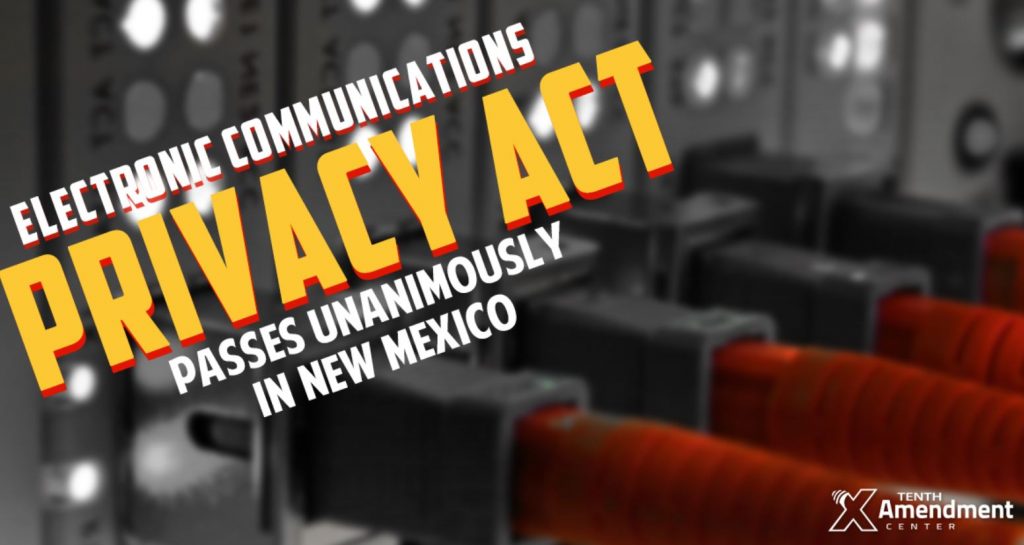Last week, the New Mexico House gave final approval for a bill known as the Electronic Communication Privacy Act. If signed by the governor, the bill would not only protect privacy in New Mexico, but would also hinder at least two aspects of the federal surveillance state.
Sen. Peter Wirth (D) and Sen. Jim Dines (D) sponsored Senate Bill 61 (SB61). The legislation would help block the use of cell site simulators, known as “stingrays.” These devices essentially spoof cell phone towers, tricking any device within range into connecting to the stingray instead of the tower, allowing law enforcement to sweep up communications content, as well as locate and track the person in possession of a specific phone or other electronic device.
The bill would require police to obtain a warrant or wiretap order before deploying a stingray device, unless they have the explicit permission of the owner or authorized possessor of the device, or if the device is lost or stolen. SB61 does provide an exception to the warrant requirement for emergency situations. Even then, police must apply for a warrant within 3 days and destroy any information obtained if the court denies the application.
SB61 would also bar law enforcement agencies from compelling a service provider or any person other than the owner of the device without a warrant or wiretap order. This would include actual communication content such as phone conversations, text messages and email, location information and other metadata such as IP addresses pertaining to a person or device participating in the communication.
Provisions in SB61 would severely limit sharing of any legally obtained data.
The legislation provides a legal remedy for anybody whose data is obtained in violation of the law.
A person in a trial, hearing or proceeding may move to suppress any electronic information obtained or retained in violation of the United States constitution, the constitution of New Mexico or the Electronic Communications Privacy Act. The motion shall be made, determined and subject to review in accordance with the procedures provided in law.
On March 16, the House passed SB61 by a 66-0 vote sending the bill to Gov. Susana Martinez’s desk for her signature. The Senate previously passed the measure by a 41-0 vote.
IMPACT ON FEDERAL SURVEILLANCE PROGRAMS
The federal government funds the vast majority of state and local stingray programs, attaching one important condition. The feds require agencies acquiring the technology to sign non-disclosure agreements. This throws a giant shroud over the program, even preventing judges, prosecutors and defense attorneys from getting information about the use of stingrays in court. The feds actually instruct prosecutors to withdraw evidence if judges or legislators press for information. As the Baltimore Sun reported in April 2015, a Baltimore detective refused to answer questions on the stand during a trial, citing a federal non-disclosure agreement.
Defense attorney Joshua Insley asked Cabreja about the agreement.
“Does this document instruct you to withhold evidence from the state’s attorney and Circuit Court, even upon court order to produce?” he asked.
“Yes,” Cabreja said.
As privacysos.org put it, “The FBI would rather police officers and prosecutors let ‘criminals’ go than face a possible scenario where a defendant brings a Fourth Amendment challenge to warrantless stingray spying.”
RFID Scan Blockers – Available for Free (Ad)
The feds sell the technology in the name of “anti-terrorism” efforts. With non-disclosure agreements in place, most police departments refuse to release any information on the use of stingrays. But information obtained from the Tacoma Police Department revealed that it uses the technology primarily for routine criminal investigations.
Some privacy advocates argue that stingray use can never happen within the parameters of the Fourth Amendment because the technology necessarily connects to every electronic device within range, not just the one held by the target. And the information collected by these devices undoubtedly ends up in federal data bases.
The feds can share and tap into vast amounts of information gathered at the state and local level through a system known as the “information sharing environment” or ISE. In other words, stingrays create the potential for the federal government to track the movement of millions of Americans with no warrant, no probable cause, and without the people even knowing it.
According to its website, the ISE “provides analysts, operators, and investigators with information needed to enhance national security. These analysts, operators, and investigators… have mission needs to collaborate and share information with each other and with private sector partners and our foreign allies.” In other words, ISE serves as a conduit for the sharing of information gathered without a warrant.
The federal government encourages and funds stingrays at the state and local level across the U.S., thereby undoubtedly gaining access to a massive data pool on Americans without having to expend the resources to collect the information itself. By placing restrictions on stingray use, state and local governments limit the data available that the feds can access.
In a nutshell, without state and local cooperation, the feds have a much more difficult time gathering information. Passage SB61 would represent a major blow to the surveillance state and a win for privacy.
PARALLEL CONSTRUCTION
 By allowing defendants to suppress information obtained in violation of the law, SB61 would hinder one practical effect of NSA spying in New Mexico.
By allowing defendants to suppress information obtained in violation of the law, SB61 would hinder one practical effect of NSA spying in New Mexico.
Reuters revealed the extent of such NSA data sharing with state and local law enforcement in an August 2013 article. According to documents obtained by the news agency, the NSA passes information to police through a formerly secret DEA unit known Special Operations Divisions and the cases “rarely involve national security issues.” Almost all of the information involves regular criminal investigations, not terror-related investigations.
In other words, not only does the NSA collect and store this data, using it to build profiles, the agency encourages state and local law enforcement to violate the Fourth Amendment by making use of this information in their day-to-day investigations.
This is “the most threatening situation to our constitutional republic since the Civil War,” Binney said.
WHAT’S NEXT
Gov. Martinez will have 20 days from the end of the session (March 18) to sign or veto SB61. If she does not act, it will be pocket vetoed.
Michael Maharrey [send him email] is the Communications Director for the Tenth Amendment Center, where this article first appeared. He proudly resides in the original home of the Principles of ’98 – Kentucky. See his blog archive here and his article archive here. He is the author of the book, Our Last Hope: Rediscovering the Lost Path to Liberty. You can visit his personal website at MichaelMaharrey.com and like him on Facebook HERE


Be the first to comment on "To The Governor: New Mexico Passes Electronic Communications Privacy Act"